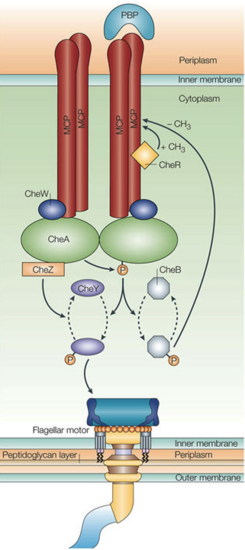User:Elizabeth R. Haglin/Sandbox 1
From Proteopedia
(Difference between revisions)
| Line 5: | Line 5: | ||
== Biological context == | == Biological context == | ||
| - | [[Image:Chemotaxis.png| | + | [[Image:Chemotaxis.png|245px|left|thumb|Chemotaxis overview <ref>PMID:15573139</ref>]] |
| - | Chemotaxis is a behavior used by most motile flagellated bacteria, like E. coli and T. maritima, to modify their swimming pattern in response to environmental stimuli. Directionality is controlled by the counter-clockwise (CCW) running or clockwise (CW) tumbling motion of the flagellar motor, which in turn is regulated by large arrays of a two-component signal transduction complex responsible for sensing extracellular chemical concentration gradients. Upon binding of a chemical ligand, the MCPs regulate ATP-dependent trans-autophosphorylation activity of the histidine kinase CheA. A repellent binding event leads to increases in phosphorylated CheA (CheA-P) and a subsequent increase in phosphorylation of CheA’s binding partner and CheY. Phosphorylated CheY (CheY-P) has a high affinity for the flagellar motor switch protein FliM and at increased concentrations will change the motor rotation from CCW to CW, leading to tumbling. Likewise, attractant binding inhibits CheA phosphorylation so unphosphorylated CheY dominates, the motor switch CCW motion is unaffected, and the cell maintains smooth swimming. The CheY-P signal is additionally regulated by the phosphatase CheZ. Ultimately, the flux of phosphoryl groups governs the mobility response to external stimuli. | + | Chemotaxis is a behavior used by most motile flagellated bacteria, like ''E. coli'' and ''T. maritima'', to modify their swimming pattern in response to environmental stimuli. Directionality is controlled by the counter-clockwise (CCW) running or clockwise (CW) tumbling motion of the flagellar motor, which in turn is regulated by large arrays of a two-component signal transduction complex responsible for sensing extracellular chemical concentration gradients. Upon binding of a chemical ligand, the MCPs regulate ATP-dependent trans-autophosphorylation activity of the histidine kinase CheA. A repellent binding event leads to increases in phosphorylated CheA (CheA-P) and a subsequent increase in phosphorylation of CheA’s binding partner and CheY. Phosphorylated CheY (CheY-P) has a high affinity for the flagellar motor switch protein FliM and at increased concentrations will change the motor rotation from CCW to CW, leading to tumbling. Likewise, attractant binding inhibits CheA phosphorylation so unphosphorylated CheY dominates, the motor switch CCW motion is unaffected, and the cell maintains smooth swimming. The CheY-P signal is additionally regulated by the phosphatase CheZ. Ultimately, the flux of phosphoryl groups governs the mobility response to external stimuli. |
== Structure == | == Structure == | ||
| - | The isolated CheA kinase exists as a homodimer of 71-kDa subunits. | + | The isolated CheA kinase exists as a homodimer of 71-kDa subunits, each of which catalyzes ATP-dependent ''trans''-phosphorylation of a histidine. A CheA monomer contains 5 domains (named P1-P5 from N- to C-terminus) connected by highly dynamic linkers of various lengths. Each domain has a distinct and important function. |
| + | *P1: a histidine phosphotransfer domain (HPt) acting as an intermediate for phosphate transfer from ATP to CheY | ||
| + | *P2: CheY binding domain releases CheY-P upon small conformational changes | ||
| + | *P3: dimerization domain | ||
| + | *P4: ATP-binding catalytic domain | ||
| + | *P5: autophosphorylation regulatory domain mediates signal input to P4 from the chemoreceptor and CheW | ||
| + | |||
=== P1P2: Histidine phosphotransfer domains === | === P1P2: Histidine phosphotransfer domains === | ||
Revision as of 19:35, 12 December 2012
| |||||||||||

